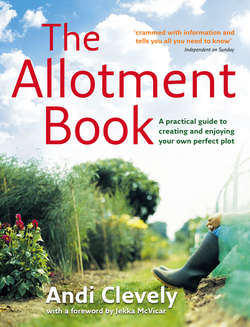Читать книгу The Allotment Book - Andi Clevely - Страница 11
EXPLORING YOUR PLOT
ОглавлениеBefore contemplating crops and how you intend to grow them, assess the plot as a place where you would enjoy working and possibly spending a lot of leisure time. Note all its apparent deficiencies as well as its merits and, if necessary, its scope for change. Although you will probably alter or adjust things as you go on, discoveries and decisions that are made now can affect future plans. Don’t rush into anything because time, weather and inclination are all unpredictable.
▸ The condition of the plot may be immediately obvious if it is overgrown, still partly planted up, or empty and cleared. Find some exposed soil and examine its character (see page 115) – plans that ignore the nature of the soil are unlikely to succeed.
▸ Note the lie of the land – whether it slopes and in which direction (this can affect temperature and the amount of sunshine it receives); low ground could be a frost-pocket or it may be waterlogged. Find out about prevailing winds. (See also pages 116 and 169.)
▸ Light and shade are important influences, so notice if existing tree canopies cast deep shadow, which might interfere with growth, or merely light shade, which is a valuable asset for sensitive crops in midsummer.
▸ Identify convenient places for essential accessories like compost bins, a shed, cold frame or manure stack. Try to find a draught-free position for sitting or eating.
▸ Access is vital: evaluate existing paths, their condition and durability, whether they are wide enough to take a wheelbarrow, and if they provide a direct, clear route to important places such as the shed, compost bin and main access road.
▸ Explore your surroundings. Locate the nearest water source, and assess any boundaries, hedges and fences for security, shelter or perhaps wild crops to harvest later. Study other plots for ideas and encouragement. Introduce yourself to neighbours, who can usually add information to your important first impressions.
AMBITION You need an aim in mind, confidence in yourself and sufficient common sense to temper your dreams with an awareness of your limitations, particularly at those times of year when a plot can seem both huge and unmanageable. Remember, though, that every year is a fresh beginning, when you can revise or simplify your plans. A plot that is too large can be shared with others or you can usually rent a part-allotment, and persistence always pays in the end.
COST If you have to buy tools, starting up can be expensive, especially if you add refinements, such as edging beds with boards and a greenhouse, shed or fruit cage. Don’t forget to include rent and travel expenses in your costs. However, you don’t have to renovate or plant up a whole allotment in the first season. You can start on the most neglected plot with just a mattock or spade and a few packets of seeds.
SEE ALSO ▸ Tools pages 54-5 Mulching page 119 The allotment year pages 166-215 Resources pages 216-18
